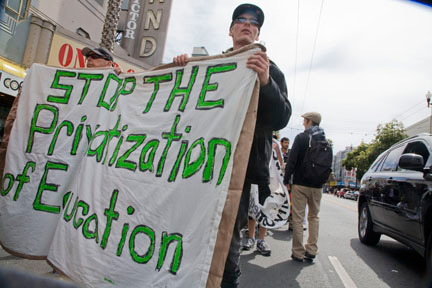
Honest, paywall-free news is rare. Please support our boldly independent journalism with a donation of any size.
On March 14, the day before the trustees at San Francisco Community College District handed in the report that may decide the life or death of California’s largest community college, student and faculty marchers headed downtown to City Hall. A sinuous line of hundreds of chanting, banner-waving people stopped traffic on Mission Street, the main artery through the city barrio. Their mood combined equal parts of desperation at the prospect of the closure of the school, and anger and defiance at the kinds of changes that authorities are demanding to keep it open.
Shanell Williams, urban studies major and president of the Associated Students at SFCC, told a rally at the march’s starting point on the college’s Mission campus that the required changes are part of a larger effort to turn students into commodities and move toward the privatization of education. “Next year, students will be affected by the Student Success Act,” she warned. “Every student will have to have an education plan; there will be repeat limits, and a 90-credit cap on the Board of Governors fee waiver [that allows poor and working-class students to petition to waive tuition fees]. Now is the time when they need more student services and support from the administration, but they’re cutting part-time counselors and taking other actions that will be even greater barriers.”
Closing San Francisco Community College became a possibility last spring, when the Accrediting Commission for Community and Junior Colleges (ACCJC) sent a team to San Francisco as part of a six-year accreditation cycle. The district, the largest public school system in California, had been warned earlier about deficiencies and knew there would be problems. With 85,000 students and 1,650 faculty and an annual operating budget of $200 million, SFCC had never been sanctioned. But under the impact of cuts in state funding, last year it had a deficit of $6 million.
In July 2012, commissioners released a set of findings that found the district deficient in 14 areas and put the district on “show cause” status, the most serious sanction short of shutting down the college entirely. The commission gave the college credit for a very diverse faculty and high-quality libraries and counseling. Commissioners said, however, that the college’s governance, planning and leadership were inefficient and that it had not documented adequately a set of assessments called “student learning outcomes.”
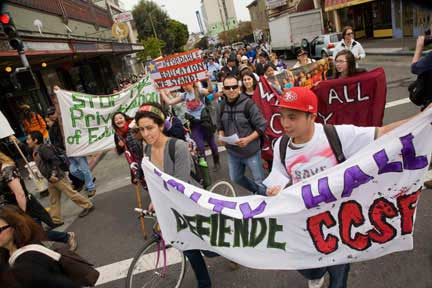 (Photo: David Bacon)
(Photo: David Bacon)Finally, the commissioners said the district fiscal planning was poor. Over the past three years of the state’s fiscal crisis, San Francisco has endured a $53 million loss in revenue. Despite it, teachers and previous chancellors worked to maintain an adequate and accessible class level and avoided layoffs through temporary cuts and concessions. But commissioners found there had not been enough cuts or cancelled classes, that too much of the budget (92 percent) was spent on personnel and that too few administrators were on staff.
After the commission made its report, then-California Community Colleges Chancellor Jack Scott went before the SFCC board of trustees and, as students hissed, told them that “What you have to do is do less than you did three years ago. There’s no other way.” Scott admitted that “all the community colleges have been faced with this very same problem.” Statewide, community colleges have incurred $809 million in cuts since 2008-2009.
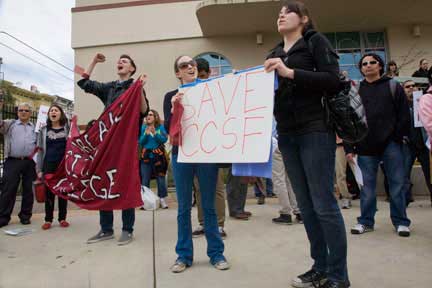 (Photo: David Bacon)
(Photo: David Bacon)But many faculty and students believe that California’s multiyear economic crisis is being used to enforce a series of changes intended to move the community college system towards privatization and attack unions as obstacles that stand in the way. “In this worldview, education reformers are beginning to look at higher education like K-12 and propose similar measures,” says Alisa Messer, president of the faculty union at SFCC, Local 2121 of the American Federation of Teachers.
“They see community colleges as a means to turn out hirable people or students for four-year institutions. We see them as institutions serving the broader community. Our students move in and out; they have jobs and kids; some are learning English as a second language, while others are seniors interested in lifelong learning. Not everyone is coming for a degree. We need an accreditation process that takes this diversity into account.”
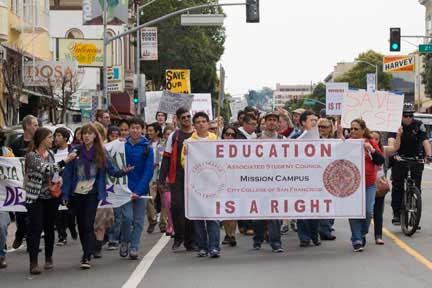 (Photo: David Bacon)
(Photo: David Bacon)In an effort to comply with the accreditation commission’s demands, however, the district brought in the Fiscal Crisis & Management Assistance Team (FCMAT), a quasi-state agency, to make recommendations for fiscal reforms. In a January 31, 2013, report, the district lists FCMAT’s demands. They dovetail with the changes demanded by the accreditation commission.
FCMAT told the district that subsidies for some education programs needed by students should be cut. Over the past several decades, the district has encouraged enrollment by establishing 11 campuses and a number of other centers. FCMAT told it to “evaluate the cost effectiveness and service requirements of the college centers to determine the best future use” and to “eliminate some of the outreach locations.” Overall, it said one important goal was to “reduce the number of full-time faculty through attrition.”
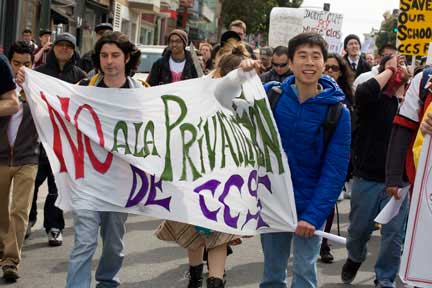 (Photo: David Bacon)
(Photo: David Bacon)FCMAT further told the district to take a hard line against its faculty and classified workers and their unions. For teachers, it suggested “negotiating reductions to the AFT contract provisions that provide benefits and compensation that may not be sustainable in the current economic environment, including compensation for tenure review committee members and mentors and generous categories of employee leave.” The district responded that it would demand “rolling back pay schedules, reducing the cost of health benefits, reducing the cost per hour for part time faculty, and/or reducing or eliminating the cost of part-time faculty health benefits.”
For the janitors, instructional aides, food service workers and other non-teachers, FCMAT told SFCC to “eliminate contract provisions that are out of the ordinary, and that increase costs” including “wellness payments … substantial paid time off, a 37.5 hour workweek, and high levels of … vacation and compensatory time.”
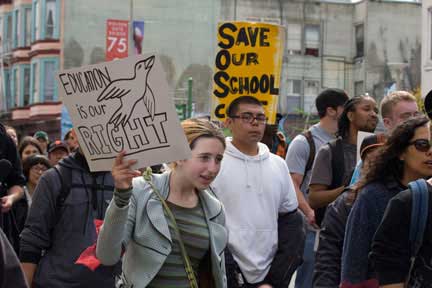 (Photo: David Bacon)
(Photo: David Bacon)Last July, Local 2121 and the district agreed to emergency measures to meet the fiscal crisis caused by the loss of state funding, including a 2.85 percent wage cut for the 2012-2013 school year. Afterwards, faculty and students hit the road to campaign for state Proposition 30 to prevent further funding cuts, and citywide Proposition A, intended to plug the hole in the district budget.
The political leaders who placed the measure on the ballot, including district trustee Anne Grier, said in their ballot argument that funds from Proposition A would be used to: “maintain core academic courses, including English, math, and science; provide workforce training, including nursing, engineering, business, and technology;
provide an education that prepares students for four-year universities; keep City College libraries and student support services open; keep technology and instructional support up to date, and offset State budget cuts.”
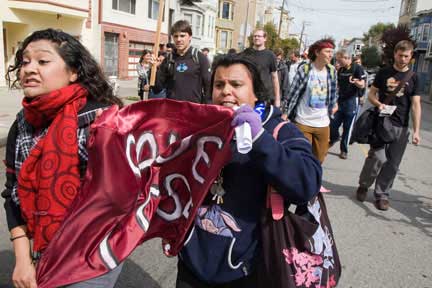 (Photo: David Bacon)
(Photo: David Bacon)The district produced budget projections, given to the union and public, that sought to show the possible results of the passage of the propositions and of their defeat. In the worst case, if both 30 and A failed, the district projected a shortfall of $24.5 million. But if both passed, it said, there would be a small surplus of $726,658.
In November voters responded, passing Prop 30. Prop A won with 73 percent of the vote. In December, however, district negotiators announced that the administration would impose a 4.4 percent “annualized” wage cut on faculty, retroactive to July, when the 2.85 percent cut took effect. Together, they would effectively cut salaries by 8.8 percent through next July. The district refused to bargain and when union negotiators persisted in demanding explanations, a new budget projection was produced. On the line where the predicted income from Proposition A had been listed previously, there was nothing.
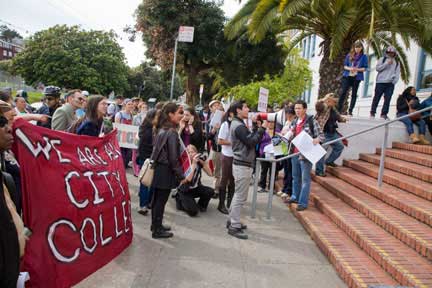 (Photo: David Bacon)
(Photo: David Bacon)After further prodding, the district announced that all Proposition A money would be used to increase the district’s reserves and better fund pension liabilities. The administration claimed this was a mandate from the ACCJC and what voters thought they were voting for was irrelevant.
This fulfilled another set of FCMAT demands, which included, “If the election results are positive … fund ongoing obligations such as retiree health benefits and workers’ compensation.” It told the district to “become more aggressive in reducing expenditures,” and to “plan for and make permanent reductions.”
Student enrollment has been falling as a result of the economic crisis, but began falling much faster when class cuts and a possible closure made it extremely insecure. That in turn caused the district’s income to fall. FCMAT’s response was to tell the district to buy a new computer software system, called Banner software, to keep better track of enrollment.
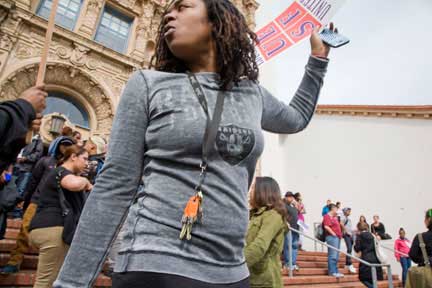 (Photo: David Bacon)
(Photo: David Bacon)In an effort to show its willingness to obey the accreditation commission and FCMAT dictates, in October the board hired a “special trustee” with the power to veto decisions he feels jeopardize the school’s response, much as appointed “special managers” in Michigan today overrule decisions made by elected city councils. The board chose Bob Agrella, past president of Santa Rosa City College, who promptly blamed the union for opposing the cuts and concessions. Its objections were keeping the college from meeting ACCJC recommendations, he claimed, and accused the union and students of trying to protect the system’s nine campuses from closure.
When students and teachers marched through the city on March 14, they were protesting the way in which the fear of closure has been used to force through ACCJC and FCMAT demands. Williams, the Associated Students president, angrily denounced the tactic as she spoke through the bullhorn at the Mission campus, surrounded by billowing banners reading, “Stop the Privatization of Education” and “We are All City College!” “Students are scared about the future of the college,” she shouted. “We need to have confidence that the administration will do what it takes to keep the college open, without squeezing out the most at-risk students or forcing extreme cuts on the faculty.”
Sanctioning community colleges is a trend growing beyond San Francisco, however: 27 districts in California (25 percent of the state total) are currently on the list. Two others in addition to SFCC have “show cause” orders that threaten closure. The accreditation commission is not a public agency but a self-perpetuating private one overseen by the Western Association of Schools and Colleges. Its primary source of funding appears to be membership dues from educational institutions, which have no input or oversight rights.
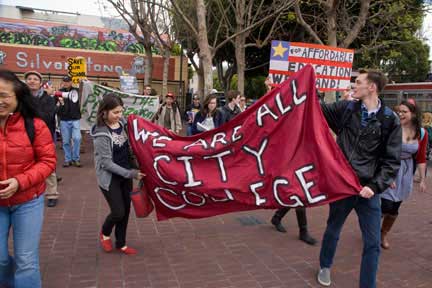 (Photo: David Bacon)
(Photo: David Bacon)What gives its recommendations power is the US Department of Education, which will fund financial aid at accredited institutions only. Particularly for community colleges, whose student body is drawn overwhelmingly from working-class communities, accreditation therefore becomes a life-or-death issue. During the Obama administration, the department has put pressure on accreditation commissions to take a harder line on sanctions, concerned that students aren’t receiving an education that enables them to get jobs and repay student loans.
Robert Shireman, director of California Competes in San Francisco and former deputy undersecretary of education in the Obama administration, told EdSource writer Louis Freedberg that although the commissions need more enforcement tools other than forcing a closure, “At some point you have to let the hatchet fall.” At the same time, the administration has discounted traditional measures of quality education, such as low ratios of students to faculty and improving college curricula. Instead, it emphasizes making graduates attractive to corporate employers.
Faculty member and Local 2121 executive board member Allan Fisher marched with the students up Mission Street and stood beside Williams as she denounced the cuts. “The source of the federal government’s pressure on the accreditation commissions to sanction more colleges,” he explained, “includes very wealthy activists like Bill Gates, who represent corporations and large foundations. Their efforts to ‘improve accountability’ through measured outcomes and the demand to push students through faster are likely to discourage students and limit educational opportunities.”
Media that fights fascism
Truthout is funded almost entirely by readers — that’s why we can speak truth to power and cut against the mainstream narrative. But independent journalists at Truthout face mounting political repression under Trump.
We rely on your support to survive McCarthyist censorship. Please make a tax-deductible one-time or monthly donation.